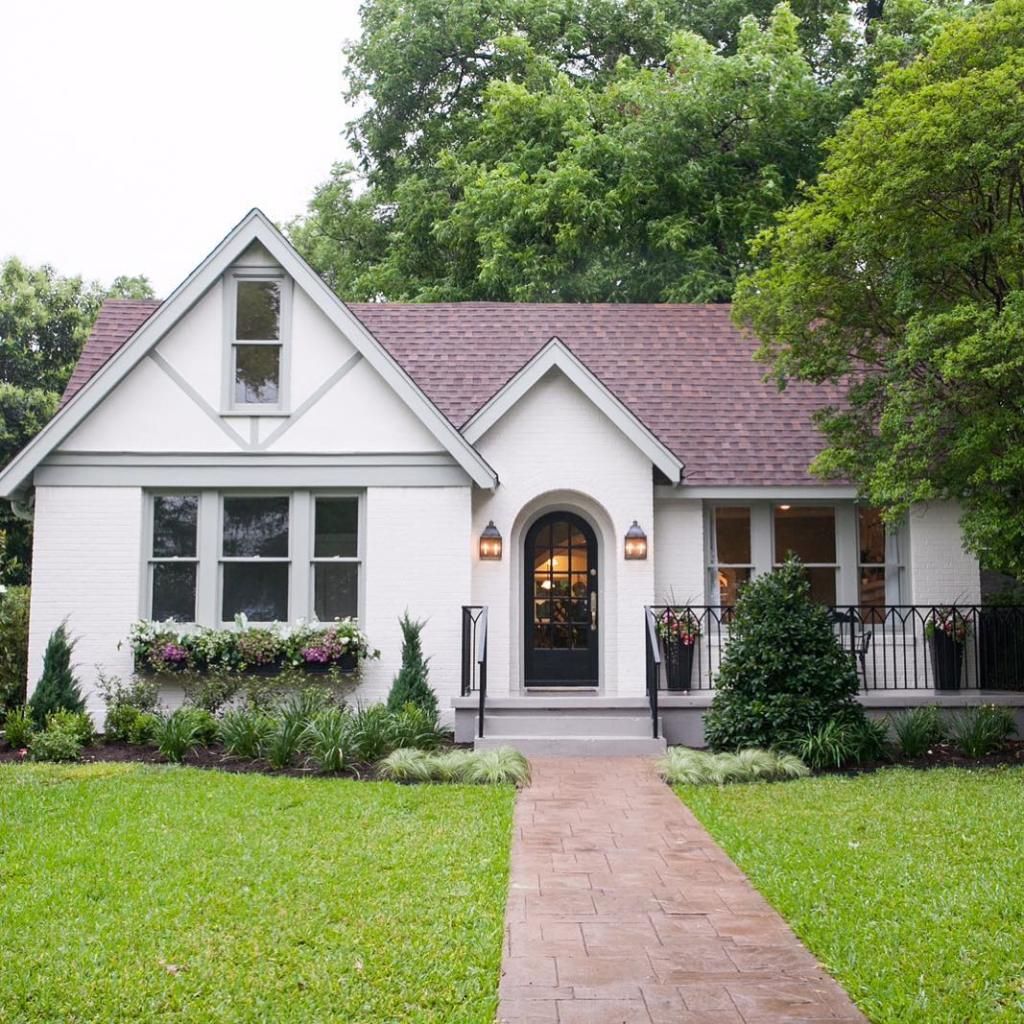Imagine stepping back in time to an era of knights and damsels, castles and moats. Now, picture the homes that these noble folk called their own—stately mansions with towering roofs and intricate wood carvings. That’s the world of English Tudor houses, architectural wonders that have stood the test of time with their timeless charm. Let’s journey into their history, discover their unique features, and learn how to bring a touch of their grandeur into your own abode.
Decoding the Allure of English Tudor Architecture
Ever walked past a house that just screams history and charm? You know, the ones with the steep, pointy roofs and those cool, exposed wooden beams? That’s the magic of an English Tudor house – a style that instantly transports you back to the time of kings and queens.
A Glimpse into the Past
Picture England in the 1500s, the Tudor dynasty is in full swing. This era wasn’t just about political drama; it was a time of incredible architectural innovation. The English Tudor style emerged, blending the sturdy, medieval designs of the past with fresh ideas inspired by the Italian Renaissance. Imagine knights and castles meeting elegant art and philosophy – that’s the essence of Tudor style!
Hallmarks of English Tudor Homes
So, how do you know if you’re looking at a real Tudor? Here are a few telltale signs:
- Dramatic Roofs: Steeply pitched, often with multiple gables (those pointy parts) that jut out at different angles. And let’s not forget the dormers – those little windows peeking out from the roof – adding character and extra light.
- Exposed Timber Framing: One of the most iconic features is the exposed timber framing. Back in the day, this wasn’t just decorative; it was a structural necessity. Today, it adds that storybook charm we all love. The spaces between the timbers were traditionally filled with brick or stucco, creating a visually striking contrast.
- Charming Casement Windows: Look closely, and you’ll notice groups of charming casement windows, often with multiple panes. These windows weren’t just for show; they were strategically placed to maximize natural light (a precious commodity in those days!).
- Asymmetrical Design: Forget perfectly symmetrical facades; Tudor houses embrace a bit of quirkiness. You might see a wing jutting out here, a tower there. It’s this asymmetry that gives them so much personality.
- Stately Chimneys: Tudor houses often boast prominent chimneys, often with decorative details. In the 1500s, a grand chimney was a status symbol, showing off your ability to heat those grand Tudor rooms.
Building a Tudor, Then and Now
Tudor houses were traditionally built using materials that were readily available: sturdy brick, locally sourced stone, and of course, plenty of timber. Today, modern builders often incorporate materials like stucco and wood siding to echo the look. And don’t forget the modern emphasis on sustainability – think energy-efficient windows and eco-friendly building practices.
Modern Tudor: Blending History with Contemporary Living
Today, you don’t have to live like a Tudor king to enjoy the style. Modern Tudor homes often take the best of the traditional design and blend it seamlessly with contemporary needs and sensibilities. Here’s how:
- Open Concept Living: Remember those grand Tudor feasts? Modern families often prefer a more open flow between the kitchen, dining, and living areas. That’s why many modern Tudor homes incorporate open floor plans, creating a sense of spaciousness while retaining the charm.
- Gourmet Kitchens: Tudor kitchens were once primarily workspaces, but today, they’re the heart of the home. Modern Tudor kitchens boast sleek appliances, custom cabinetry, and maybe even a massive kitchen island, all without sacrificing that classic Tudor elegance.
- Spa-Like Bathrooms: No more chamber pots or cold baths! Modern Tudor bathrooms are all about luxury and relaxation, featuring spa-like showers, soaking tubs, and elegant fixtures that complement the overall style.
- Energy Efficiency: No one wants to heat (or cool) a drafty old house. Modern Tudor homes incorporate energy-efficient features like double-paned windows, proper insulation, and energy-saving appliances, keeping your utility bills in check and your conscience clear.
- Enchanting Gardens: Think lush gardens with formal hedges, charming pathways winding through colorful blooms, and cozy nooks for enjoying your morning coffee. Landscaping is an essential part of the modern Tudor aesthetic, creating a seamless transition between the indoors and the enchanting outdoors.
Living the Tudor Life: Pros & Cons
Owning a piece of history is a dream for many, and an English Tudor house certainly fulfills that fantasy. But like any home, it’s important to weigh the pros and cons:
The Upsides:
- Timeless Elegance: Tudor style has an enduring appeal that never goes out of fashion. It’s a look that’s both classic and full of character.
- Uniquely You: Forget cookie-cutter houses! A Tudor home is a statement piece, instantly recognizable and sure to stand out in any neighborhood.
- A Wise Investment?: Well-maintained English Tudor homes often hold their value well and may even appreciate over time, making them a potentially good long-term investment.
Things to Consider:
- Maintenance: Those charming timber frames and intricate details do require special care and attention. Be prepared for more specialized (and potentially costly) maintenance compared to a newer home.
- Natural Light: Traditional Tudor homes often have smaller windows, which, while charming, may result in slightly darker interiors. However, modern adaptations often remedy this with larger windows and skylights.
- Layout Limitations: The traditional Tudor layout, while charming, might require some creative renovations to suit modern living. Open-concept living, for example, often requires removing walls, which needs to be done carefully to preserve the structural integrity of these older homes.
Owning an English Tudor home is about more than just bricks and mortar; it’s about embracing a piece of history and infusing it with your own personal style. It’s about cozy evenings by the fireplace, imagining the stories those ancient timbers could tell. It’s about creating a home that’s as unique and enchanting as the Tudor era itself.
What Defines an English Tudor House?
So, we’ve talked about a few things already, but let’s dive into what really makes a house scream “English Tudor.” Think exposed wooden beams – the “half-timbering” that was essential for building strong houses back then. They’d use these wooden frames and then fill the spaces with brick or plaster. It’s like the building is whispering its history to you!
And speaking of whispering history, have you noticed those roofs? Steep, with all those gables and twists and turns – they’re not just for show. England gets its fair share of rain and snow, and those roofs were designed to keep the inside dry. Plus, all those nooks and crannies in the attic? Storage galore! It’s like having a secret room in your roof.
Speaking of secrets, have you ever wondered about those chimneys? They’re practically works of art! Often clustered together, these chimneys were essential for heating those grand Tudor homes during the chilly English winters. Imagine huddling around a crackling fire with the family.
Now, peek inside—see those tall, narrow windows? They’re called casement windows, and they’re a classic Tudor touch. These windows, often with charming diamond-shaped panes, weren’t just about letting in light and air—they also added a touch of elegance and sophistication.
Here’s a fun fact: unlike the perfectly symmetrical houses you might see in other architectural styles, Tudor homes were all about embracing the unexpected. They were built and expanded over time, resulting in these charmingly irregular floor plans. It’s like each room has its own story to tell.
And let’s not forget the materials! Tudor homes were all about natural beauty, showcasing the timeless elegance of timber, brick, and stone. It’s a style that truly embodies the English countryside.
English Tudor vs. French Tudor: Distinguishing the Styles
While they share some family features, like those super-steep, storybook roofs, English Tudor and French Tudor homes have some key differences. Think of it like this: English Tudor is your charming cottage in the countryside, while French Tudor is its sophisticated cousin who lives in a chateau.
English Tudor homes are all about that cozy, asymmetrical charm. Picture a house with a roofline that zigzags this way and that, with little gables popping up here and there. They often show off those sturdy wooden beams, and the spaces between are often filled with brick or plaster. The windows are tall and narrow, letting in slivers of light like a medieval castle, and they’re often framed with beautiful stone or brick.
But perhaps the most eye-catching feature of an English Tudor is the chimney situation. We’re not talking about one lonely chimney here. These houses often have multiple chimneys, grouped together, and they’re not afraid to dress up for the occasion. They might have decorative chimney pots or fancy brickwork, adding a touch of grandeur to the whole house. English Tudors love a good detail. You’ll probably spot things like hood molds over the doors and windows, horizontal lines called stringcourses, and even decorative caps called finials perched on the roof peaks.
Now, let’s hop across the English Channel and visit our French Tudor friends. These homes also love a good steep roof and decorative half-timbering, but they’re a bit more buttoned-up than their English counterparts. They tend to be more symmetrical and formal. The windows are often larger, letting in more light, and the ornamentation is more elaborate, with carved stonework and those little towers called turrets. Instead of a jumble of chimneys, French Tudors often have a grand central entrance, sometimes flanked by towers, giving them a stately, imposing look.
So, while both English and French Tudor homes share that fairy tale charm, remember that English Tudors are all about cozy asymmetry and rustic details, while French Tudors lean towards symmetry, grandeur, and a more polished look.
Where Can You Find Tudor Houses in the USA?
While you might stumble upon a Tudor home in almost any state, certain areas in the U.S. seem to have a particular fondness for the Tudor style. They tend to cluster in places where their aesthetic fits in just right.
Take the Northeast, for example. This region, with its weather often mirroring the chilly dampness of England, proved to be fertile ground for the Tudor Revival. The style, originally designed for a similar climate, just worked – both practically and aesthetically. It’s no wonder that states like Virginia, New York, and Pennsylvania boast a higher concentration of these charming abodes.
Interestingly, Washington, D.C. also embraced the Tudor Revival. The nation’s capital, however, opted for a slightly grander approach. Instead of the cozy, storybook feel we often associate with Tudors, D.C. went with a more imposing, stately interpretation of the style. These impressive homes often stood shoulder to shoulder with their Colonial Revival cousins, creating a fascinating architectural blend.
Even though the Tudor Revival’s heyday was back in the 1920s and 30s, these homes haven’t faded into obscurity. They continue to capture the imagination, popping up in pockets across the country. So, while your chances of stumbling upon a Tudor are higher in the Northeast, don’t rule out a discovery in other parts of the U.S.!
If you’re looking for charming interior design ideas, why not check out our English country house collection? You’ll find plenty of inspiration for creating a warm and inviting home.
When planning the lighting for your entryway, consider using a variety of fixtures to create a welcoming and functional space. Check out our guide on entry foyer lighting for some ideas.
- White Kitchen With Wood Countertops: A Warm Design - January 7, 2026
- Modern Butcher Block Kitchen: Warmth and Style with White Cabinets - January 6, 2026
- White Cabinets with Butcher Block Countertops: A Kitchen Classic - January 5, 2026










